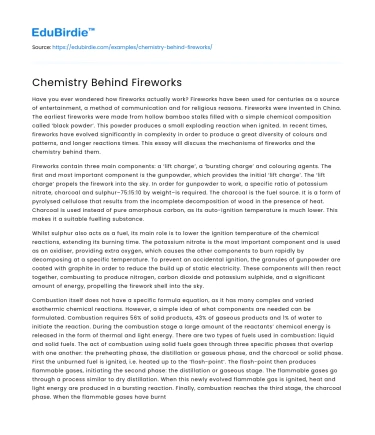Have you ever wondered how fireworks actually work? Fireworks have been used for centuries as a source of entertainment, a method of communication and for religious reasons. Fireworks were invented in China. The earliest fireworks were made from hollow bamboo stalks filled with a simple chemical composition called ‘black powder’. This powder produces a small exploding reaction when ignited. In recent times, fireworks have evolved significantly in complexity in order to produce a great diversity of colours and patterns, and longer reactions times. This essay will discuss the mechanisms of fireworks and the chemistry behind them.
Fireworks contain three main components: a ‘lift charge’, a ‘bursting charge’ and colouring agents. The first and most important component is the gunpowder, which provides the initial ‘lift charge’. The ‘lift charge’ propels the firework into the sky. In order for gunpowder to work, a specific ratio of potassium nitrate, charcoal and sulphur–75:15:10 by weight–is required. The charcoal is the fuel source. It is a form of pyrolysed cellulose that results from the incomplete decomposition of wood in the presence of heat. Charcoal is used instead of pure amorphous carbon, as its auto-ignition temperature is much lower. This makes it a suitable fuelling substance.
Save your time!
We can take care of your essay
- Proper editing and formatting
- Free revision, title page, and bibliography
- Flexible prices and money-back guarantee
Whilst sulphur also acts as a fuel, its main role is to lower the ignition temperature of the chemical reactions, extending its burning time. The potassium nitrate is the most important component and is used as an oxidiser, providing extra oxygen, which causes the other components to burn rapidly by decomposing at a specific temperature. To prevent an accidental ignition, the granules of gunpowder are coated with graphite in order to reduce the build up of static electricity. These components will then react together, combusting to produce nitrogen, carbon dioxide and potassium sulphide, and a significant amount of energy, propelling the firework shell into the sky.
Combustion itself does not have a specific formula equation, as it has many complex and varied exothermic chemical reactions. However, a simple idea of what components are needed can be formulated. Combustion requires 56% of solid products, 43% of gaseous products and 1% of water to initiate the reaction. During the combustion stage a large amount of the reactants’ chemical energy is released in the form of thermal and light energy. There are two types of fuels used in combustion: liquid and solid fuels. The act of combustion using solid fuels goes through three specific phases that overlap with one another: the preheating phase, the distillation or gaseous phase, and the charcoal or solid phase. First the unburned fuel is ignited, i.e. heated up to the ‘flash-point’. The flash-point then produces flammable gases, initiating the second phase: the distillation or gaseous stage. The flammable gases go through a process similar to dry distillation. When this newly evolved flammable gas is ignited, heat and light energy are produced in a bursting reaction. Finally, combustion reaches the third stage, the charcoal phase. When the flammable gases have burnt up all of their energy and cannot maintain flames, and the fuel no longer burns rapidly, it will have a low glow and will then only smoulder. The gases produced by the burning of gunpowder: nitrogen, carbon dioxide and potassium sulphide, build up inside the firework shell. Eventually the pressure becomes so great the capsule explodes, thus initiating the first stage in a firework reaction: the ‘lift charge’.
The second phase includes the bursting charge and the scattering of the colouring agents or ‘stars’. Once the initial lift charge explodes, it triggers another delayed fuse. This burns to the centre of the shell and bursts after a predetermined amount of time and thus a particular altitude. The force of the explosion will be strong enough to break the shell and propel the stars in every direction. The stars contain the same components as gunpowder, plus metal salt compounds, which produce different colours depending on the types of metals in the compounds. Depending on how the stars are packed, they can form different patterns. These stars are coated with an extra layer of gunpowder in order to further enhance the reaction.
Colours are produced using two methods: incandescence and luminescence. Incandescence occurs when a substance is heated to an extreme temperature and begins to glow. The heated substance will firstly emit infrared, then in order from red, orange yellow and eventually white light, as the heat increases. Some metals that use the incandescence method include: aluminium, magnesium and titanium, which burn very brightly. Luminescence, on the other hand, is the most common method for the production of colour by fireworks. Luminescence is light emitted due to the excitation of electrons in a chemical reaction. It can be produced at relatively low temperatures and is often referred to as “cold light”. Once the bursting charge is ignited, the electrons of the metals in the colourant become excited, absorbing heat from the combustion reaction, thus causing them to elevate to a higher energy level. However, they will return to their original ground state almost immediately, due to the instability of the excited state. As these electrons return, they will release some energy in the form of light. Specific colours can be emitted from different types of metal salt compounds.
To summarise, fireworks are a complex diversity of chemical reactions. Fireworks require two phases in order to activate. The first phase involves the lift charge, which utilises the combustion of gunpowder to propel the firework shell into the air. The second stage involving the delayed combustion of the bursting charge, exploding to project and ignite the carefully packed stars into various patterns. Using the chemical process of luminescence and the emissions released by the excitation of electrons to produce an array of colours, thus combining art and chemistry.






 Stuck on your essay?
Stuck on your essay?

